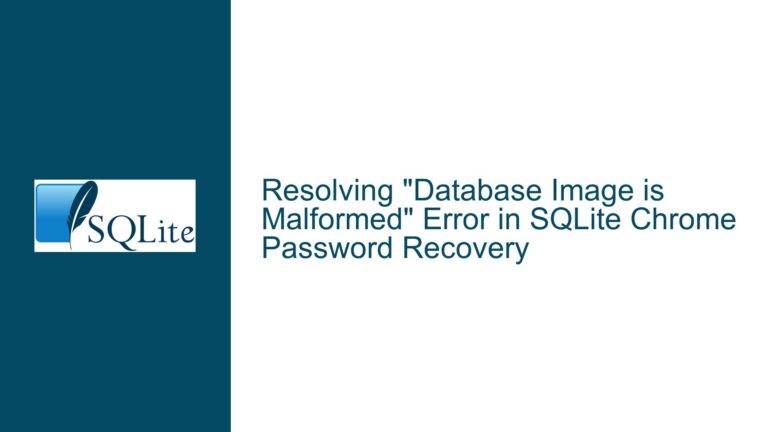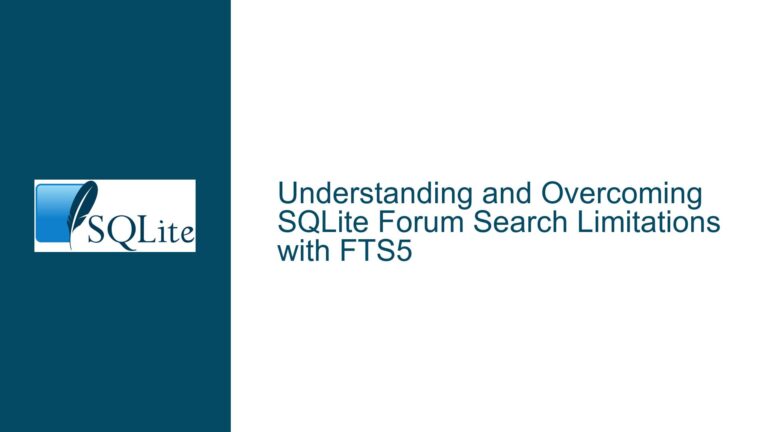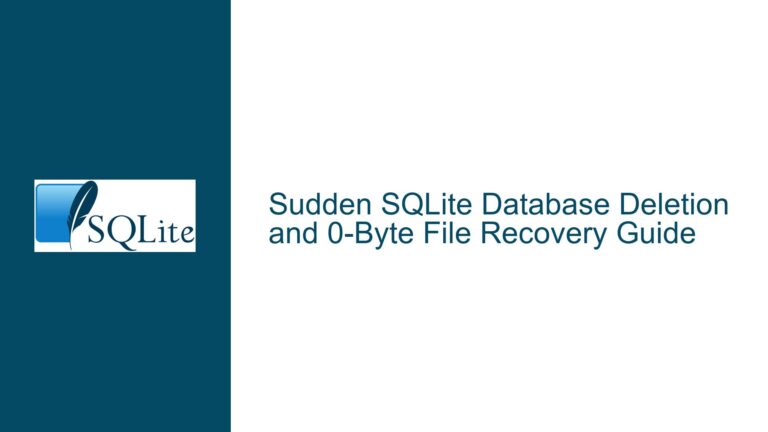Ensuring Consistent SQLite WAL Mode Backups via File Copying: Locking, Checkpoints, and Process Isolation
Issue Overview: Inconsistent Database State Risks During WAL File Copying
The core challenge revolves around creating a reliable hot backup of an SQLite database operating in Write-Ahead Logging (WAL) mode by directly copying the database file (*.db) and its associated WAL file (*-wal). This method aims to avoid the disk space overhead of SQLite’s Online Backup API or VACUUM INTO, which create temporary copies of the database. However, WAL mode introduces complexities due to its two-file architecture (main database + WAL journal), which stores uncommitted transactions and pending writes. Copying these files while the database is actively used risks capturing an inconsistent state if the backup process does not account for:
- Atomic coordination between the main database and WAL file.
- Concurrent write operations modifying the database during the copy.
- Operating system file locking behaviors that may invalidate the backup.
The original discussion highlights two competing priorities:
- Minimizing disk space usage by avoiding temporary copies (critical for resource-constrained environments).
- Guaranteeing backup consistency despite concurrent database access.
Key technical nuances include:
- The role of
BEGIN IMMEDIATEtransactions to enforce write exclusivity. - The interaction between
PRAGMA wal_checkpoint(TRUNCATE)and subsequent locking. - Platform-specific file locking semantics (POSIX vs. Windows) affecting backup reliability.
- Thread/process isolation requirements to prevent interleaved operations during backup.
Possible Causes: Why WAL File Copying Fails Without Proper Coordination
1. Uncoordinated Checkpointing and Lock Acquisition
Executing PRAGMA wal_checkpoint(TRUNCATE) followed by BEGIN IMMEDIATE does not guarantee atomicity. Another thread or connection might write to the database between these two operations, causing the WAL file to grow again before the lock is acquired. This results in a backup containing a main database file that reflects the checkpointed state but a WAL file with newer, uncheckpointed transactions. On restore, SQLite will detect a mismatch between the main database and WAL file, leading to database corruption or automatic WAL file deletion (data loss).
2. Incomplete File Set Backup
Omitting the WAL file during copying (e.g., assuming wal_checkpoint(TRUNCATE) has emptied it) risks missing uncheckpointed transactions. Even after a truncating checkpoint, the WAL file may not be fully empty if concurrent readers prevent its truncation.
3. Process/Thread Contention During Copy
If the backup copy is performed by the same process holding the database lock (via BEGIN IMMEDIATE), platform-specific file locking behaviors can inadvertently release the lock. For example:
- POSIX Systems: Opening/closing a file descriptor in the same process releases all locks held by that process on the file.
- Windows: File locks are tied to handles, but abrupt process termination can leave locks unresolved until reboot.
4. Compression and Streaming Overheads
Directly compressing the database file during backup (e.g., piping tar to gzip) introduces latency. If the copy process is slow, the time window for concurrent writes to modify the database increases, even if a lock is held.
5. Restoration Protocol Flaws
Restoring a backup without removing residual WAL files from the target environment can lead to SQLite attempting to recover using an incompatible WAL file. This is especially problematic if the original database was modified after the backup was taken.
Troubleshooting Steps, Solutions & Fixes: Achieving Atomic, Space-Efficient Backups
Step 1: Enforce Write Exclusivity with Proper Lock Sequencing
To ensure no writes occur during the backup, acquire a reserved lock using BEGIN IMMEDIATE and hold it until the copy completes:
# Python example using APSW (similar logic applies for other languages)
import apsw
# Dedicated connection for backup coordination
backup_conn = apsw.Connection("main.db")
backup_conn.cursor().execute("BEGIN IMMEDIATE")
# Perform backup here (see Steps 2-4)
backup_conn.cursor().execute("COMMIT")
Critical Considerations:
- Use a dedicated connection solely for acquiring/releasing the lock. Do not execute other queries on this connection.
- Terminate all other write transactions before initiating the backup.
Step 2: Checkpoint the WAL File Before Locking (Conditionally)
Executing PRAGMA wal_checkpoint(TRUNCATE) before acquiring the lock reduces the WAL file size but does not eliminate the need to back it up. Use this pragma only if:
- All active database connections use
journal_mode=WAL. - No long-running read transactions are active (they block WAL truncation).
Modified Workflow:
- Checkpoint the WAL:
backup_conn.cursor().execute("PRAGMA wal_checkpoint(TRUNCATE)") - Immediately acquire the lock:
backup_conn.cursor().execute("BEGIN IMMEDIATE") - Verify WAL size:
wal_size = os.path.getsize("main.db-wal") if wal_size > 0: # Backup both files else: # Backup main.db only
Step 3: Isolate the Copy Process at the OS Level
To avoid lock contention and POSIX/Windows locking quirks, delegate the file copy to a separate process (not thread):
POSIX Example (Bash):
# Process 1: Python script
import subprocess
# Acquire lock
backup_conn.cursor().execute("BEGIN IMMEDIATE")
# Launch copy process
subprocess.run(["tar", "czf", "backup.tar.gz", "main.db", "main.db-wal"])
# Release lock
backup_conn.cursor().execute("COMMIT")
Windows Example (PowerShell):
# Process 1: Python script
backup_conn.cursor().execute("BEGIN IMMEDIATE")
subprocess.run(["powershell", "Compress-Archive -Path main.db, main.db-wal -DestinationPath backup.zip"])
backup_conn.cursor().execute("COMMIT")
Step 4: Streamline Compression Without Intermediate Files
To avoid disk space overhead, pipe the output of the copy directly to a compression tool:
Using Named Pipes (POSIX):
mkfifo /tmp/db_pipe
gzip -c /tmp/db_pipe > backup.db.gz &
tar -cf - main.db main.db-wal > /tmp/db_pipe
rm /tmp/db_pipe
Caveats:
- Ensure the compression tool reads from the pipe fast enough to prevent blocking.
- Test for atomicity: The entire
taroutput must be captured in the compressed stream without partial reads.
Step 5: Validate Backup Consistency on Restore
After restoring from a backup:
- Delete any residual WAL files:
rm restored.db-wal - Open the database and force a checkpoint:
PRAGMA quick_check; PRAGMA wal_checkpoint(TRUNCATE); - Verify integrity:
PRAGMA integrity_check;
Alternative Solutions When Disk Space is Constrained
If direct file copying is untenable:
Option 1: Use .dump and Stream Compression
sqlite3 main.db .dump | gzip > backup.sql.gz
Pros:
- Generates a text-based backup smaller than binary files.
- Avoids WAL complexities entirely.
Cons:
- Restore requires re-integrating indexes and constraints.
- Slower for large databases.
Option 2: Use VACUUM INTO with Pipes
# Use a named pipe to stream the output
os.mkfifo("/tmp/vacuum_pipe")
subprocess.Popen(["gzip", "-c", "/tmp/vacuum_pipe", ">", "backup.db.gz"])
cursor.execute("VACUUM INTO '/tmp/vacuum_pipe'")
os.remove("/tmp/vacuum_pipe")
Pros:
- Produces a compressed, optimized database.
- Atomic operation without locking.
Cons:
- Requires SQLite 3.27+ for
VACUUM INTO. - May still use temporary disk space during
VACUUM.
By methodically addressing lock coordination, process isolation, and platform-specific behaviors, developers can safely back up WAL-mode SQLite databases via file copying while minimizing disk space usage. Always validate backups through checksum verification and test restores in a staging environment.






